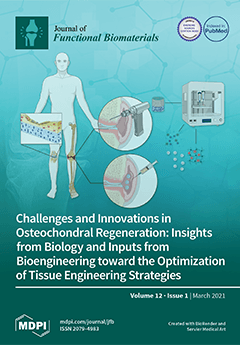Open AccessArticle
Electrospun Poly(butylene-adipate-co-terephthalate)/Nano-hyDroxyapatite/Graphene Nanoribbon Scaffolds Improved the In Vivo Osteogenesis of the Neoformed Bone
by
Luana Marotta Reis Vasconcellos, Gabriela F. Santana-Melo, Edmundo Silva, Vanessa Fernandes Pereira, Juliani Caroline Ribeiro Araújo, André Diniz Rosa Silva, André S. A. Furtado, Conceição de Maria Vaz Elias, Bartolomeu Cruz Viana, Fernanda Roberta Marciano and Anderson Oliveira Lobo
Cited by 18 | Viewed by 3599
Abstract
Electrospun ultrathin fibrous scaffold filed with synthetic nanohydroxyapatite (nHAp) and graphene nanoribbons (GNR) has bioactive and osteoconductive properties and is a plausible strategy to improve bone regeneration. Poly(butylene-adipate-co-terephthalate) (PBAT) has been studied as fibrous scaffolds due to its low crystallinity, faster biodegradability, and
[...] Read more.
Electrospun ultrathin fibrous scaffold filed with synthetic nanohydroxyapatite (nHAp) and graphene nanoribbons (GNR) has bioactive and osteoconductive properties and is a plausible strategy to improve bone regeneration. Poly(butylene-adipate-co-terephthalate) (PBAT) has been studied as fibrous scaffolds due to its low crystallinity, faster biodegradability, and good mechanical properties; however, its potential for in vivo applications remains underexplored. We proposed the application of electrospun PBAT with high contents of incorporated nHAp and nHAp/GNR nanoparticles as bone grafts. Ultrathin PBAT, PBAT/nHAp, and PBAT/nHAp/GNR fibers were produced using an electrospinning apparatus. The produced fibers were characterized morphologically and structurally using scanning electron (SEM) and high-resolution transmission electron (TEM) microscopies, respectively. Mechanical properties were analyzed using a texturometer. All scaffolds were implanted into critical tibia defects in rats and analyzed after two weeks using radiography, microcomputed tomography, histological, histomorphometric, and biomechanical analyses. The results showed through SEM and high-resolution TEM characterized the average diameters of the fibers (ranged from 0.208 µm ± 0.035 to 0.388 µm ± 0.087) and nHAp (crystallite around 0.28, 0.34, and 0.69 nm) and nHAp/GNR (200–300 nm) nanoparticles distribution into PBAT matrices. Ultrathin fibers were obtained, and the incorporated nHAp and nHAp/GNR nanoparticles were well distributed into PBAT matrices. The addition of nHAp and nHAp/GNR nanoparticles improved the elastic modulus of the ultrathin fibers compared to neat PBAT. High loads of nHAp/GNR (PBATnH5G group) improved the in vivo lamellar bone formation promoting greater radiographic density, trabecular number and stiffness in the defect area 2 weeks after implantation than control and PBAT groups.
Full article
►▼
Show Figures






